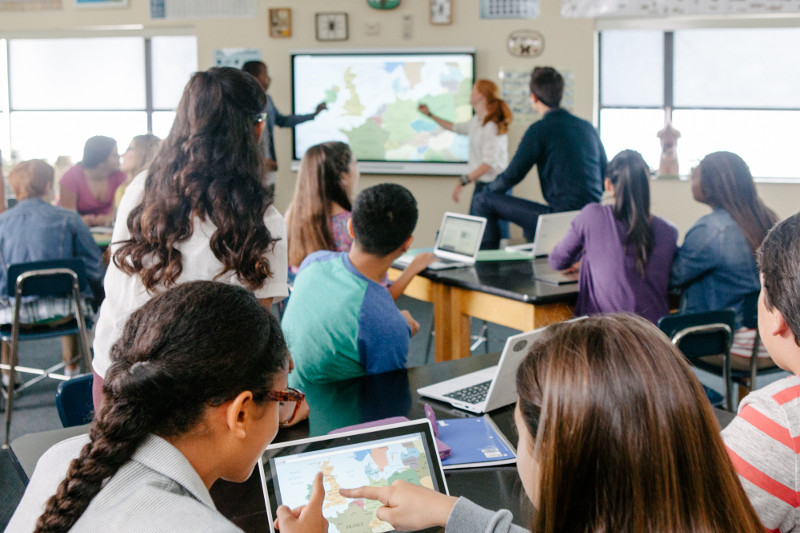Distraction or Encourages Interaction? Technology in the Classroom
There is no question that classrooms across America are experiencing a technological revolution. But is the rapidly increasing amount of screen time a valuable asset to the learning experience or a diversion from in-class lessons?
How many times per day do you think you check your phone? Twenty? Thirty? Fifty?
According to Apple, the average iPhone user unlocks their phone eighty times per day, and taps, swipes, or types more than 2,600 times per day.
While the majority of this screen time comes during after-school hours, cell phones have become a classroom staple, with or without teacher permission.
Trying to connect with a generation dependent on screens, many school districts across the country encourage the incorporation of technology into the learning environment to engage students in their lessons and promote the use of collaboration and teamwork skills.
North Allegheny School District began its FOCUS 2020 project during the 2015-2016 school year. This project aims to leverage technology in the classroom to innovate educational practices and “prepare students for success in a changing world.” By 2020, the goal is for every high school student to have their own laptop and every middle school and elementary school student to have their own iPad in order to enhance their learning experience.
At North Allegheny Intermediate High School (NAI), smart boards have replaced projectors, laptops have overshadowed notebooks, and online textbooks and databases have made hardcover books a thing of the past. Surrounded by technology, today’s teachers have more opportunities than ever before to devise new and creative ways to make learning exciting.
A favorite online activity among students is online review games, such as Quizlet Live and Kahoot, which are often used to break up the daily lectures and test students’ understanding of the concepts taught at the same time.
Sophomore Alexa Palka says, “I have found that Quizlets and Kahoots are most beneficial in my opinion. Both are interactive, and being a hands-on and visual learner, these help me understand the material. I am also the type of person who has to be very organized, so Quizlet also acts as a way to make flashcards without all the paper.”
However, several NAI teachers find that the most advantageous use of modern technology is to promote group discussions that provide students with the opportunity to learn from each other. Websites such as Padlot and Actively Learn encourage each student to communicate their own ideas, comments, or questions with their peers to provide different views on the same topic.
“I feel the most beneficial thing about technology in the classroom is being able to use online discussion and lab resources for reinforcement of content. Using Padlet for class discussion has worked well to introduce content for my class. It gets students involved in discussion that might not want to actually speak up in regular class setting. Students have different learning styles, so this is one more way to use information to help keep all types of students interested and help them understand the content. ” says biology teacher Mrs. Scholtz.
Even with their valiant efforts to capture their students’ eyes and ears, the window of opportunity for teachers to do so is rapidly decreasing. A Microsoft study found that since 2000, the influence of cell phones and technology has shortened the human attention span to from twelve to eight seconds, which is now one second shorter than that of a goldfish.
On a typical day, cell phones are supposed to be put away during class, but the vibrating sensation in a pocket or the familiar glow of the screen when a notification comes through is practically impossible for students to ignore and immediately becomes their main focus for the rest of the class period.
Cell phones are not the only distraction in the classroom. Although they greatly enhance a student’s learning experience, laptops can also be a danger in class. Under the disguise of completing an assignment or taking notes, students are easily tempted to play online games or shop online during class instead of paying attention to the teacher. This results in a noticeable decrease in assignment and test scores in both high school and college students.
According to tenth grade math teacher Mrs. Holland, “I can honestly say that there is a direct correlation between cell phone use or laptop use (playing games, etc. ) in class. The scores on test, quizzes or assignments are lower. Each time a student is on their phone or computer, they are missing dialogue or instruction time.”
Today, it is nearly impossible to imagine a day at NAI without the incorporation of technology into daily lessons. Although it promotes interaction and active participation within the classroom, if not used at the correct time and for the sole purpose of learning, technology can become a detrimental distraction.

Grade: 10
Years on Staff: 1
Role: staff writer
Life Soundtrack (song): The Sound of Sunshine-Michael Franti & Spearhead
Short bio: Eliza...


